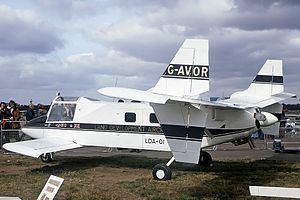Wingspan 8.84 m Manufacturer Lockspeiser | Length 6.86 m | |
 | ||
The Lockspeiser LDA-01 ("Land Development Aircraft") was a British seven-tenths scale research and development tandem wing aircraft, which was designed and built by the late David Lockspeiser to prove a concept for a low-cost utility transport.
Contents
Design and development
The LDA-01 was a single-seat tandem-wing monoplane, fabric covered with metal construction. The foreplane had a common design to the separately-made port and starboard wings of the main plane, giving it half the area. The intention was to reduce the number of spare parts needed by re-using the same wing component interchangeably in each location. The main wings were mounted at the rear-end of the box structure fuselage and the fore wing was attached underneath the front. The fuselage was fitted with a four wheeled landing gear and was designed to be fitted with a detachable payload container to allow easy conversion between roles. It was powered by a rear-mounted pusher engine. The LDA-01 G-AVOR first flew on 24 August 1971 at Wisley in Surrey, under the power of an 85 hp (63 kW) Continental C85 piston engine, but was later refitted with a more powerful Lycoming O-320 engine.
The aircraft (which by this time had been re-registered G-UTIL), and had been renamed the Boxer 500, was being modified to planned production configuration by Brooklands Aerospace at Old Sarum Airfield when it was destroyed in a fire on 16 January 1987.
Specifications
Data from British Civil Aircraft since 1919 and Jane's All The World's Aircraft 1976-77.
General characteristics
Performance
